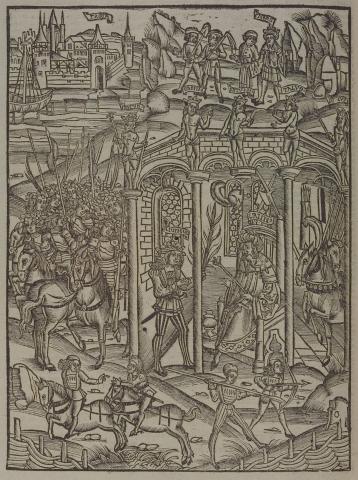Annotations
In the background, Aeneas prepares to break ground on a new city for his people, and three others hold tools necessary for building a city (157-9). In the foreground, Latin youths exercise; two practice their skills in weaponry, while two train their horses (162-5). In the center of the image, on the right-hand side, Ilioneus and King Latinus converse in the palace of Picus, an important ceremonial building. On columns just outside the building stand statues of the famed ancestors of the Latins: two-faced Janus, Sabinus, Saturnus holding a sickle, Italus, and Picus holding a scepter (170-82). Vergil does not include Picus in the list of statues, and instead simply mentions him as the original inhabitant of the palace. Brant's interpretation allows Picus to be a visible part of the palace, and the scepter in his hand illustrates the tradition of kings taking up the scepter in this building.
In the palace room, above the heads of the two men, a plumed helmet and captured arms hung up on the walls indicate the prowess of the city in war (183-6). As for the men themselves, Latinus sits in a modest throne (193), while Ilioneus stands before him with a wreath in his hair, holding out an olive branch as an offering of peace (236-7). Behind Latinus are two horses, which represent the large number of finely caparisoned horses given to the Trojans by Latinus. These horses are shown on the left, and the 100 Trojans who accompanied Ilioneus to the palace are shown riding them (274-9). In the upper left corner of the image, the city of Troy is shown as an island floating on the river. While its presence in the image is unclear, it may represent the model the Trojans would use to build their new city. (Katy Purington)
Woodcut illustration from the “Strasbourg Vergil,” edited by Sebastian Brant: Publii Virgilii Maronis Opera cum quinque vulgatis commentariis expolitissimisque figuris atque imaginibus nuper per Sebastianum Brant superadditis (Strasbourg: Johannis Grieninger, 1502), fol. 292v, executed by an anonymous engraver under the direction of Brant.


Sebastian Brant (1458-1521) was a humanist scholar of many competencies. Trained in classics and law at the University of Basel, Brant later lectured in jurisprudence there and practiced law in his native city of Strasbourg. While his satirical poem Das Narrenschiff won him considerable standing as a writer, his role in the transmission of Virgil to the Renaissance was at least as important. In 1502 he and Strasbourg printer Johannes Grüninger produced a major edition of Virgil’s works, along with Donatus’ Life and the commentaries of Servius, Landino, and Calderini, with more than two hundred woodcut illustrations. (Annabel Patterson)